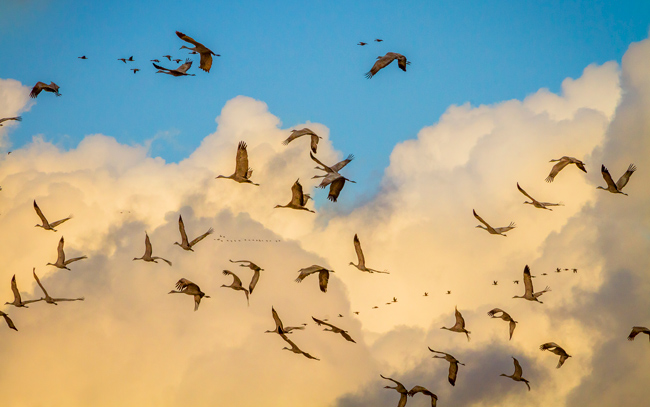 In early March we drove to Nebraska, picked up my sister in Lincoln, and then went on to Kearney to see the great Sandhill Crane migration.
In early March we drove to Nebraska, picked up my sister in Lincoln, and then went on to Kearney to see the great Sandhill Crane migration.
If you’ve never heard of the migration don’t feel bad. I grew up in Nebraska and until last year, I was completely unaware of it.
This is a bit of break from my usual posts which chiefly focus on photography books, history and criticism.
The amazing thing is, it’s one of the greatest animal migrations on earth. Thousands of Sandhill Cranes begin arriving along the Platte River in late February and stay through March. At night they sleep in the River because it offers protection from predators (The Platte, as the pioneers said, is a “mile wide and an inch deepâ€). The sound of an animal approaching through the water is a giveaway and the birds can quickly take flight.
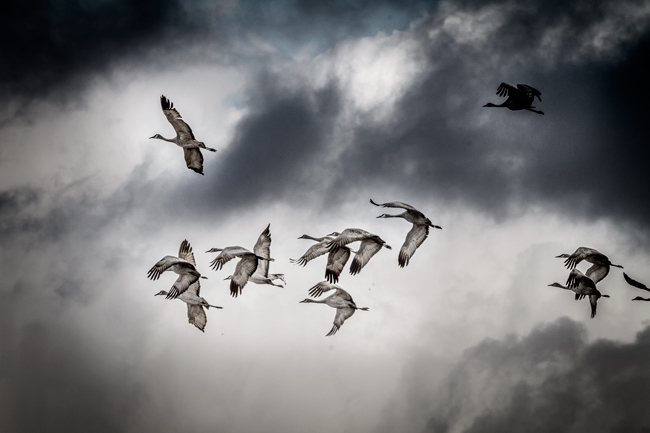 We made arrangements to visit a blind along the river in the early morning (think getting up at 5 a.m.). It was a foggy, moonless morning and going out to the blind was something of a test of our dedication. The pathway is unlit (the better not to disturb the cranes) and even the guides admitted it was the blackest night/morning they could recall.
We made arrangements to visit a blind along the river in the early morning (think getting up at 5 a.m.). It was a foggy, moonless morning and going out to the blind was something of a test of our dedication. The pathway is unlit (the better not to disturb the cranes) and even the guides admitted it was the blackest night/morning they could recall.
How dark?
Dark enough that had a woman standing in front of me not been wearing a light-colored jacket I would have been hopelessly lost. Dark enough that if I held my hands up in front of my eyes I still couldn’t see them.
As it was, I couldn’t shake the image of one person at the front of the line veering off into the river and all of us following to form a massive pileup in the Platte. The headline would read: 15 bird watchers drown in freak accident after getting lost on path.
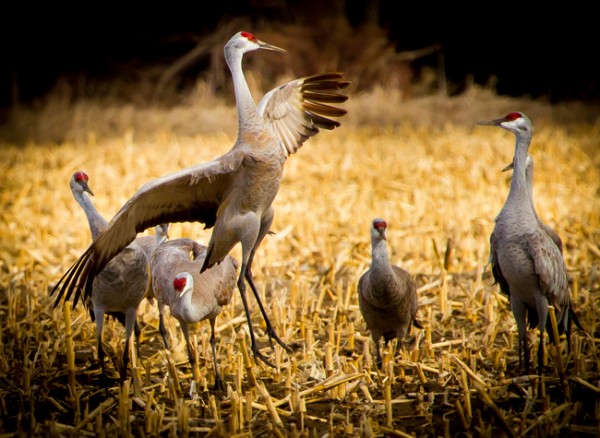
The Crane Dance. The Cranes leap into the air, giving themselves extra lift with their wings. They frequently use their beaks to grab a piece of corn stalk, grass or whatever else seems handy and then toss it into the air while leaping.
We shuffled into the blind feeling our way along the wall. They told us there were benches on one side and windows on the other. We touched our way to the benches and then waited for the dim light to show us more than the outlines of the windows. It was a long wait.
Finally, in the dim light I spotted something on the river. Too dark to be sure with my own eyes, I set the camera for a long exposure and took a shot. I knew it would be blurry and unusable, but perhaps I could at least verify the bird sitting in the river.

Another Crane photographer. We struck up a conversation and found we had a lot in common. In fact we happened to be married to each other.
It worked. And, as I looked at the image on the back of the camera I spotted the familiar white and black neck and head of…you guessed it…a Canada Goose.
In fact, by the time the sun came through the clouds, the cranes had already left the river for the surrounding cornfields. No worry though – there were plenty of cranes to see during the day.
How many are there? At the peak, we’re talking several hundred thousand birds – all congregating in a 75-mile stretch of the Platte River valley. They sleep in the river and then at sunrise or just before the sun comes up, they fan out to the surrounding countryside, where they feed. The harvested cornfields along the river provide perfect feeding grounds for the cranes, which forage for grain left in the fields and anything else they can eat.

During the day the cranes fan out to the surrounding cornfields and gorge themselves, fattening up for the long flight north.
The birds repeat the routine for a month or so, fattening up for their flight north to their breeding grounds, which can range from Minnesota to Alaska, Canada and even Siberia. Â Like Hawks, Eagles and Vultures they soar on thermals, which conserves energy.
I’ve read that under the right conditions, the thick flocks of cranes can make the normally invisible patterns of the thermals visible as they ride the wind.
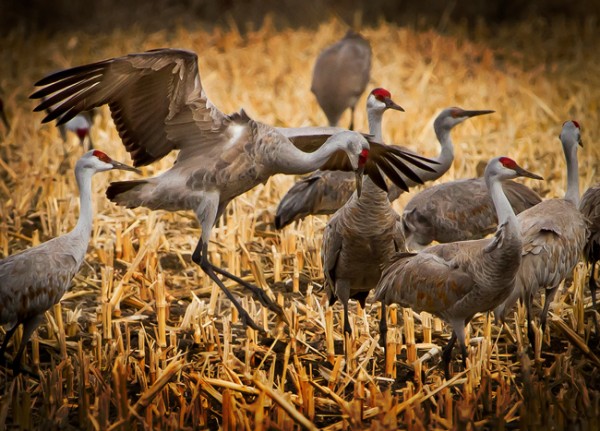
As spectacular as the Crane Dance is, I noticed that the other birds often seem indifferent to the display. Perhaps the women are sending them a message that the men don’t quite understand?
The birds do perform an interesting dance, leaping and throwing corn stalks, grass or other debris in the air. Although it’s referred to as a mating dance and that, apparently is its primary purpose, I’ve read the Cranes often dance even when they are not trying to attract a mate.
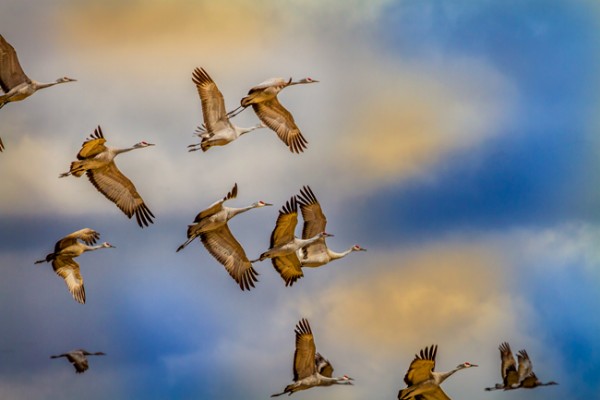 The migration has been taking place for millions of years. Yes, that’s right – millions of years. A fossil found in the Platte dates back some 10 million years ago. Although if you want to be a stickler for accuracy, it was probably an ancestor of today’s genus and not identical to the species we see today. On the other hand though, the oldest fossil of what is clearly a Sandhill Crane is still 2.5 million years old.
The migration has been taking place for millions of years. Yes, that’s right – millions of years. A fossil found in the Platte dates back some 10 million years ago. Although if you want to be a stickler for accuracy, it was probably an ancestor of today’s genus and not identical to the species we see today. On the other hand though, the oldest fossil of what is clearly a Sandhill Crane is still 2.5 million years old.
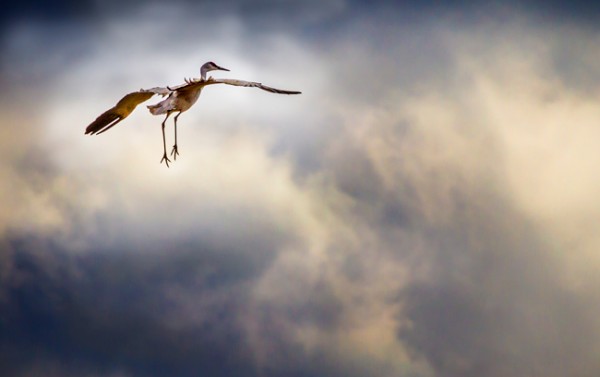
As I was watching the cranes land I was struck by how primitive and dinosaur-like they appear. They don’t cruise in like most birds, but follow a maneuver that I can only describe as “falling” from the sky. They form their wings into something like a parachute and basically just allow themselves to drop out of the sky. I could really imagine seeing a Pterodactyl doing this.
That’s a little hard for me to grasp. The dawn of modern man is placed between 60,000 and 80,000 years ago in Africa. Some researchers believe man may have arrived in the Americas as early as 50,000 years ago. Others put it much later
T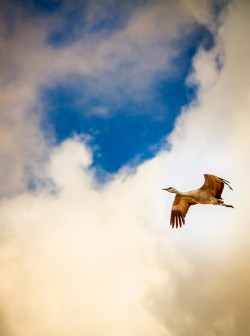 hat still leaves the cranes here for 2,450,000 years before man set foot on the continent; and if you include the earlier fossil species, we’re talking about 9.95 million years before man arrived in the Americas.
hat still leaves the cranes here for 2,450,000 years before man set foot on the continent; and if you include the earlier fossil species, we’re talking about 9.95 million years before man arrived in the Americas.
Times like that are almost impossible for me to fathom. The contrast is remarkable. The earliest archeological records date the first semi-permanent residents of the Platte to about 1,000 years ago.
A blink of the eye to the Cranes.
